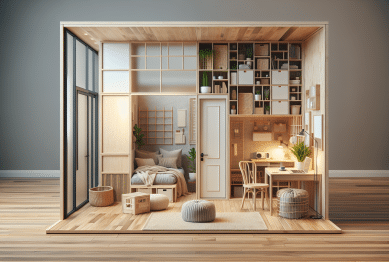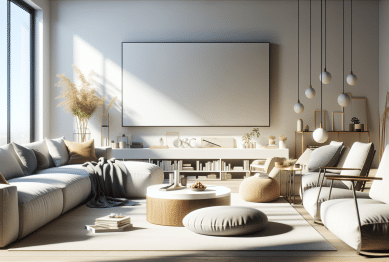Discover practical strategies for minimalist living that go beyond decluttering. This guide explores how simplicity can transform physical spaces, boost mental clarity, support lasting happiness, and create room for what truly matters. Explore why minimalist lifestyles are attracting new attention in wellness and entertainment circles.
The Foundations of Minimalist Living
Minimalist living is more than just owning less. It’s a mindset that focuses on creating space—physically and mentally—for what genuinely brings happiness. At its heart, minimalism encourages thoughtful choices, favoring quality over quantity and letting go of belongings or habits that no longer serve a true purpose. Many embrace minimalism to find calm within the chaos of modern lifestyles, where clutter often adds unnecessary stress. Decluttering might begin with the closet or kitchen, but the real change happens in daily routines and how decisions are made about new purchases or commitments.
This lifestyle invites a new appreciation for simplicity and intentionality. Instead of chasing endless trends or accumulating items, minimalist living means appreciating what you already have. It fosters gratitude and encourages mindfulness—being fully present in each moment. By reducing distractions caused by excess possessions, people often find clarity and a deeper connection to their core values. Whether it’s transitioning to a capsule wardrobe, limiting digital notifications, or simplifying schedules, each step creates more space for rest and enjoyment.
One remarkable benefit is the emotional relief that comes with releasing clutter. Research shows that organized and tidy spaces can noticeably lower feelings of anxiety and overwhelm (Source: https://www.apa.org/news/press/releases/2022/03/declutter-mind). Minimalist living empowers individuals to focus attention on meaningful relationships and experiences rather than endless possessions. By welcoming this approach, everyday life becomes lighter—and often, a lot more joyful.
The Key Habits That Anchor Simplicity
Building habits around minimalist living starts with regular reflection. Take time each week to pause and ask, “Does this still add value?” Whether the question concerns home décor, subscription services, or recurring appointments, it helps refine what’s essential. The goal is to cultivate routines that prevent the build-up of excess in the first place. Many discover that simplifying morning and evening routines provides stability and calm throughout the rest of the day. For some, that means prepping meals in advance; for others, it’s about finishing each day by tidying up living spaces just a little bit.
Prioritization is another central minimalist tool. It’s easier to say ‘yes’ or ‘no’ when the most important goals and personal values are clear. Some people keep a list of their core values on display to guide daily choices—everything from scheduling social events to deciding whether to bring something new into the home. With visual reminders, the temptation to accumulate ‘just in case’ items or overconsume entertainment drops. This habit also applies to digital life. Unsubscribing from unnecessary emails or unfollowing overwhelming social media accounts often brings instant relief and a surprising sense of control.
Lastly, setting boundaries—both physical and emotional—makes minimalism sustainable. For example, a simple rule like ‘one in, one out’ can prevent the accumulation of clutter. Many embrace designated ‘quiet nights’ without screens to restore balance and encourage restful sleep. By weaving minimalist habits into everyday living, this approach becomes less about restriction and more about freedom and fulfillment, reinforcing the sense that less really can be more.
Transforming Spaces with Minimalist Design
Minimalist design has become a popular way to invite peace and light into homes, offices, or studios. This style is characterized by open floor plans, ample natural light, and the intentional use of neutral colors. It embraces clean lines and functional furnishings rather than ornate or excessive decorations. When choosing which items to keep, minimalists often look for versatility and durability, preferring multi-use furniture or high-quality pieces that last. The aim is to create spaces that feel restful and inspiring, not empty or cold.
Organizing experts often recommend starting with one category at a time—such as clothing, kitchen gadgets, or reading materials. This prevents decision fatigue and makes the transformation process more manageable. Real-life minimalists report that small changes, like keeping countertops clear or choosing open shelving, can dramatically shift a room’s atmosphere. The focus turns toward showcasing a few cherished items and making everyday tools easy to access. For families, this sometimes means rethinking kids’ spaces, too—rotating toys and reducing visual stimulation can lead to calmer playtimes (Source: https://childmind.org/article/decluttering-childrens-toys/).
Bringing nature indoors is another minimalist trick. A single plant or a vase of flowers becomes the highlight of a room, offering the soothing effects of greenery without cluttering shelves. Minimalist living doesn’t mean sacrificing personality—rather, it showcases authenticity and celebrates each chosen detail. The results often inspire visitors and can even make home maintenance much simpler, freeing up precious time for leisure or social connection.
The Mental Wellness Connection to Minimalism
Simplifying the environment doesn’t just affect physical surroundings; it profoundly impacts mental well-being, too. Studies indicate that cleaner, less cluttered spaces can lead to improved focus and reduced depressive symptoms (Source: https://www.psychologytoday.com/us/basics/decluttering). Minimalism is about eliminating distractions, which allows for deeper rest and more intentional living. People often report greater awareness of their emotions and increased resilience after shedding excess belongings and commitments.
Many extend the concept of minimalist living to emotional boundaries. By re-examining relationships and obligations, it becomes easier to prioritize positivity and mutual respect while gently letting go of draining connections. This mindset can also support a more mindful approach to technology: taking breaks from constant notifications, limiting device usage late at night, and rethinking engagement with endless scrolling or streaming. These shifts all lighten the mental load. In entertainment, this sometimes means seeking out meaningful activities, like music, art, or mindful movement, instead of overconsuming content.
Calm and clarity aren’t the only results. Minimalists often develop a strong sense of agency—feeling more in control of how time and energy are used. The process fosters self-compassion and patience, making it easier to handle setbacks with grace. Ultimately, minimalist living proves that real entertainment and happiness often come from within or from shared experiences, rather than the endless chase for more.
Minimalist Living for Families and Communities
Minimalist approaches are not reserved for single adults or couples—families and even entire communities can benefit. Slow living movements, which overlap with minimalism, encourage spending deliberate time together, ditching packed schedules for more meaningful interactions. Discussing values and goals as a household helps everyone align their expectations and clarify which belongings or habits add value (Source: https://www.nytimes.com/2022/06/15/well/family/minimalism-decluttering-family.html).
Shared minimalist practices might include communal decluttering days or neighborhood swap events. These encourage sustainable habits and build connections between neighbors, making minimalism feel less isolating. For families, working together to streamline routines—like creating shared chore lists or minimizing holiday excess—reduces stress. Learning to celebrate together with presence over presents teaches children lasting lessons about gratitude and resourcefulness. The family home can become a sanctuary for growth, laughter, and rest—a place free from the pressures of constant consumption.
Minimalism’s influence can even extend to digital communities. Many people form online groups to support each other in simplifying routines, share creative minimalist entertainment ideas, or trade resources (Source: https://www.apartmenttherapy.com/minimalist-lifestyle-36994675). This approach encourages accountability, inspires new projects (like upcycling or small-space gardening), and turns minimalist living into a vibrant, communal adventure. Success comes from collaboration and a shared desire to live more intentionally and fully.
Entertainment, Hobbies, and the Joy of Less
Contrary to the myth, minimalist living doesn’t equal boring. In fact, it can spark more creativity and fun. With fewer distractions, hobbies and favorite activities become richer and more fulfilling. Many people rediscover childhood interests—like playing an instrument, painting, or handwriting letters—once the noise of excess is gone. Minimalism also encourages spending more time outdoors, exploring public parks, or volunteering, which brings joy that isn’t connected to consumption (Source: https://greatergood.berkeley.edu/article/item/seven_ways_to_have_more_fun_with_less_stuff).
The entertainment industry has also noticed this shift. Minimalist themes now appear in film, fashion, and interior design shows, inspiring millions to try a slower, simpler approach. Many streaming platforms offer documentaries that highlight the benefits of decluttered lifestyles and the joys of sustainable living. By focusing on experience instead of acquisition, individuals find new pleasure in laughter, shared meals, board games, or calm evenings with a good book.
It’s about making room for inspiration. Artists and creatives often say that minimalism “clears the canvas” for their best work. Fewer possessions mean less to maintain or worry about, freeing up more mental energy and time. As hobbies become intentional priorities instead of impulse purchases, entertainment becomes deeply satisfying—and life feels much lighter overall.
References
1. American Psychological Association. (2022). Declutter Your Mind: How Organization Impacts Mental Wellness. Retrieved from https://www.apa.org/news/press/releases/2022/03/declutter-mind
2. Child Mind Institute. (n.d.). Decluttering Your Child’s Toys. Retrieved from https://childmind.org/article/decluttering-childrens-toys/
3. Psychology Today. (n.d.). Decluttering. Retrieved from https://www.psychologytoday.com/us/basics/decluttering
4. The New York Times. (2022). Minimalism with Family: How to Declutter Together. Retrieved from https://www.nytimes.com/2022/06/15/well/family/minimalism-decluttering-family.html
5. Apartment Therapy. (2022). The Minimalist Lifestyle Is More Popular Than Ever. Retrieved from https://www.apartmenttherapy.com/minimalist-lifestyle-36994675
6. Greater Good Science Center. (n.d.). Seven Ways to Have More Fun with Less Stuff. Retrieved from https://greatergood.berkeley.edu/article/item/seven_ways_to_have_more_fun_with_less_stuff









